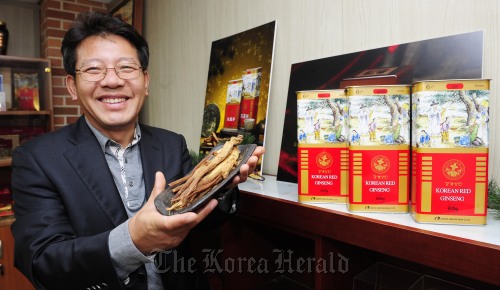Sam Heung aims to become Korean pride in the global market
The domestic market for red ginseng is estimated to reach 1.2 trillion won ($1 billion) this year, driven by its growing popularity among health-conscious Koreans.
With the state-run Korea Ginseng Corp. enjoying more than 75 percent of the market, Sam Heung has been in a “David and Goliath” battle for the past 14 years.
“The market has recently become a battle field for large latecomers. There has been no easy period for us,” CEO Youn Chung-kwang, 50, told The Korea Herald.
“Maintaining the quality of products has always been the way to survive hard times.”
Gwanghwa and Gaeseong in Gyeonggi Province have been popular for their quality ginseng since the Goryeo era. During the Joseon period, there were traders called “Songsang” who exported ginseng to China.
They steamed and dried ginseng into red roots to make it lighter to carry ― methods later found to increase the effectiveness of ginseng ingredients such as saponins.
Youn’s great-grandfather was the descendant of the Songsang. His parents also continued to provide ginseng to the government until the late 1990s.
However, the traditional family business seemed to be fading with the implementation of the government monopoly act on ginseng between 1955 and 1996.
Then in 1997, when the ban on ginseng sales was lifted among citizens, Youn who had been a salary man for 13 years decided to revive his family’s tradition.
“I had long thought of processing red ginseng by myself. While working in the retail industry, I recognized the quality of Gwanghwa ginseng could make it an international product,” he said.
“More than other things, I realized red ginseng is a precious family business that should be maintained constantly.”
 |
Youn Chung-kwang, CEO of Sam Heung, shows dried ginseng at his office in Gimpo, Gyeonggi Province. (Park Hae-mook/The Korea Herald) |
But he had to learn everything from the beginning for himself, largely depending on his vague memories from when his mother and grandmother worked together to make red ginseng.
“There was nobody to teach me. During the first three years, I may have dumped ginseng worth hundreds of thousands of won,” Youn said.
“It was extremely difficult to standardize the whole process of red ginseng production.”
After trial and error, he finally succeeded in reviving the traditional way of processing ginseng using only the sun and wind in the clean environment of the Gwanghwa area.
It takes 60 days to dry and another 10 days for the ginseng to mature.
Currently, other large companies use hot wind from machines to dry the ginseng so that the drying time is reduced to only five to seven days.
The hand made process, Youn said, dramatically improves the effectiveness of his company’s red ginseng products.
“Compared to other companies, our ginseng products contain a higher percentage of saponins. Our figure for the effectiveness in strengthening immunity is also more than double other products,” Youn said citing a recent survey.
And the red ginseng products are sold at major retailers under the brand name “Kanggaesangin,” which reflects the tradition of the ancient ginseng traders.
“My father didn’t want me to take over the ailing business. But after the company was established and the first products came out, he seemed happy even though he didn’t express it directly,” Youn said.
Finding a distribution channel was another barrier for the new and small company.
Then, Shinsegae Department Store recognized the quality of Samgheung’s red ginseng and began selling the products at its locations nationwide and in its sister supermarket chain E-Mart.
The partnership with Shinsegae, which has continued for more than a decade, also boosts the premium image of the red ginseng products, he said.
In order to control the quality of products, Youn visits every corner of the country where quality ginseng is grown every September and October.
“We are still a small company with 10 billion won in annual sales. But in the end customers who have tried our products would recognize our efforts. That’s my pride,” he said.
The company also started exporting its products to overseas markets. The first batch worth 60 million won was sent to Hong Kong this year.
“I visited France few years ago and found that a bottle of wine produced at an old winery was priced at tens of millions of won,” he said.
“I have no doubt that Korean red ginseng could become a such a luxury food item favored by people around the world. So I believe the family business will be maintained in the future.”
By Lee Ji-yoon (
jylee@heraldcorp.com)




![[Herald Interview] 'Trump will use tariffs as first line of defense for American manufacturing'](http://res.heraldm.com/phpwas/restmb_idxmake.php?idx=644&simg=/content/image/2024/11/26/20241126050017_0.jpg)

![[Health and care] Getting cancer young: Why cancer isn’t just an older person’s battle](http://res.heraldm.com/phpwas/restmb_idxmake.php?idx=644&simg=/content/image/2024/11/26/20241126050043_0.jpg)

